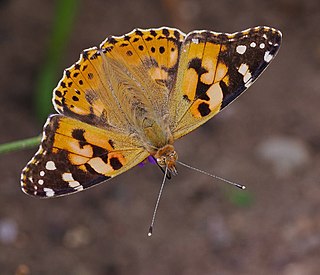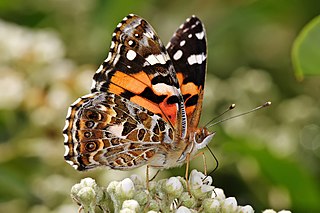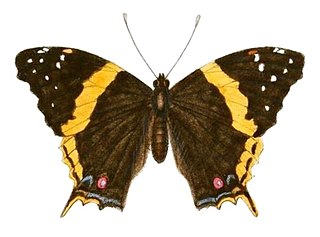
Danainae is a subfamily of the family Nymphalidae, the brush-footed butterflies. It includes the Daniadae, or milkweed butterflies, who lay their eggs on various milkweeds on which their larvae (caterpillars) feed, as well as the clearwing butterflies (Ithomiini), and the tellervini.

Cynthia is a group of colourful butterfly species that used to be considered a subgenus of the genus Vanessa, in the family Nymphalidae. Before that, it was first described as a genus. Nowadays, this group is not considered a valid taxon anymore, because it is paraphyletic. The name CynthiaFabricius, 1807 is now a junior subjective synonym of VanessaFabricius, 1807.

Vanessa atalanta, the red admiral or, previously, the red admirable, is a well-characterized, medium-sized butterfly with black wings, red bands, and white spots. It has a wingspan of about 2 inches (5 cm). It was first described by Carl Linnaeus in his 1758 10th edition of Systema Naturae. The red admiral is widely distributed across temperate regions of North Africa, the Americas, Europe, Asia, and the Caribbean. It resides in warmer areas, but migrates north in spring and sometimes again in autumn. Typically found in moist woodlands, the red admiral caterpillar's primary host plant is the stinging nettle ; it can also be found on the false nettle. The adult butterfly drinks from flowering plants like Buddleia and overripe fruit. Red admirals are territorial; females will only mate with males that hold territory. Males with superior flight abilities are more likely to successfully court females. It is known as an unusually calm butterfly, often allowing observation at a very close distance before flying away, also landing on and using humans as perches.

The Nymphalidae are the largest family of butterflies, with more than 6,000 species distributed throughout most of the world. Belonging to the superfamily Papilionoidea, they are usually medium-sized to large butterflies. Most species have a reduced pair of forelegs and many hold their colourful wings flat when resting. They are also called brush-footed butterflies or four-footed butterflies, because they are known to stand on only four legs while the other two are curled up; in some species, these forelegs have a brush-like set of hairs, which gives this family its other common name. Many species are brightly coloured and include popular species such as the emperors, monarch butterfly, admirals, tortoiseshells, and fritillaries. However, the under wings are, in contrast, often dull and in some species look remarkably like dead leaves, or are much paler, producing a cryptic effect that helps the butterflies blend into their surroundings.

Vanessa cardui is the most widespread of all butterfly species. It is commonly called the painted lady, or formerly in North America the cosmopolitan.

Vanessa is a genus of brush-footed butterflies in the tribe Nymphalini. It has a near-global distribution and includes conspicuous species such as the red admirals, the Kamehameha, and the painted ladies of the Cynthia group : Painted lady, American painted lady, West Coast lady, Australian painted lady, etc. For African admirals, see genus Antanartia. Recently, several members traditionally considered to be in the genus Antanartia have been determined to belong within the genus Vanessa.

Adelpha californica, the California sister, is a species of butterfly in the family Nymphalidae. They are common in California, but can also be found in western Nevada and Oregon, as well as in northern Baja California. The upper surfaces of their wings are dark brown to black with wide cream white bands dissecting both wings and two orange patches near the tips of the forewings. The underside is variously colored with browns, blue, orange, and white. A. californica is unpalatable to predators and is part of a large mimicry complex.
Butterfly evolution is the origin and diversification of butterflies through geologic time and over a large portion of the Earth's surface. The earliest known butterfly fossils are from the mid Eocene epoch, between 40-50 million years ago. Their development is closely linked to the evolution of flowering plants, since both adult butterflies and caterpillars feed on flowering plants. Of the 220,000 species of Lepidoptera, about 45,000 species are butterflies, which probably evolved from moths. Butterflies are found throughout the world, except in Antarctica, and are especially numerous in the tropics; they fall into eight different families.

The Australian painted lady is a species of butterfly mostly confined to Australia, although westerly winds have dispersed it to islands east of Australia, including New Zealand. Debate surrounds the taxonomy of this species. Some believe that the Australian painted lady should be a subspecies of the painted lady due to the similarity in lifestyle and behaviour. Furthermore, the painted lady is found around the globe, but Australia is the only location in which it varies enough to be considered a separate species.

The butterfly subtribe Euptychiina is a diverse group within the tribe Satyrini, occurring throughout Central and South America, in addition to a few species known from North America. Euptychiina is a predominantly lowland group, with the exception of one Asian taxon Palaeonympha opalinaButler, 1871 and the Andean genus ForsterinariaGray, 1973. The taxon was erected by Lee Denmar Miller.

Vanessa vulcania, the Canary red admiral, is a butterfly of the family Nymphalidae. It is found on the Canary Islands and Madeira. Previously, it was considered a subspecies of Vanessa indica, but has been raised to species level after research by Leestmans in 1992.

Antanartia, commonly called (African) admirals, is a genus in the family Nymphalidae found in southern Africa. They live along forest edges and are strongly attracted to rotting fruit and plant juices. For other admirals see genus, Vanessa. Recently, three species traditionally considered to be members of Antanartia have been moved to Vanessa based on molecular evidence. Antanartia borbonica was not sampled by the study, but was purported to belong in Antanartia based on morphological similarity.

Many populations of Lepidoptera migrate, sometimes long distances, to and from areas which are only suitable for part of the year. Lepidopterans migrate on all continents except Antarctica, including from or within subtropical and tropical areas. By migrating, these species can avoid unfavorable circumstances, including weather, food shortage, or over-population. In some lepidopteran species, all individuals migrate; in others, only some migrate.

Adelpha bredowii, the Bredow's sister, is a species of butterfly in the family Nymphalidae. It is endemic to western, central, and southern Mexico. Adelpha bredowii belongs to the serpa species group in the genus Adelpha (sisters). Adelpha bredowii previously included two subspecies, the California sister and the Arizona sister. Recent phylogenetic studies, however, conclude that morphological, geographical, and genetic evidence make it clear that these are correctly separate species. They have been reclassified as the species Adelpha californica and Adelpha eulalia, respectively.

Vanessa hippomene, commonly known as the southern short-tailed admiral, is a butterfly of the family Nymphalidae which is native to South Africa and Madagascar.

Vanessa dimorphica is a butterfly of the family Nymphalidae. It is found in Africa.

Vanessa abyssinica, the Abyssinian admiral, is a butterfly in the family Nymphalidae. It is found in Ethiopia, Kenya, Tanzania, Uganda, Rwanda and the Democratic Republic of the Congo. The habitat consists of montane forests.

Adelpha eulalia, the Arizona sister, is a species of butterfly in the family Nymphalidae. It occurs from at least Guatemala and Mexico to the southwestern United States, including southeastern California, Arizona, New Mexico, and southern Texas. They can also sometimes be found in Oklahoma, Kansas, Colorado, Utah, and Nevada.

Vanessa carye, the western painted lady, is a butterfly of the family Nymphalidae. It is found in South America, from the mountains of Colombia and west of Caracas (Venezuela) through Ecuador, Peru, Bolivia, Chile, southern Brazil, and Paraguay to Patagonia in Argentina. It is also found on Easter Island and Tuamotus.

















